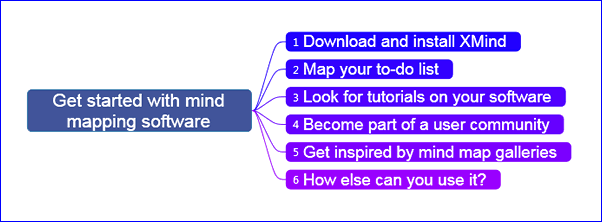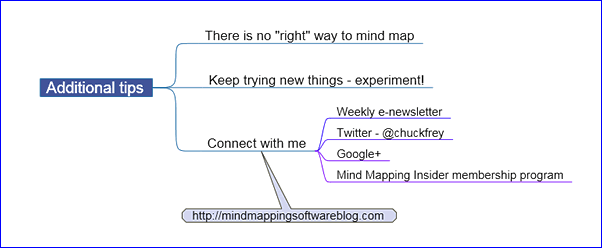One of the most common questions I get from people is, “How do I get started with mind mapping software?” Here is a simple 6-step process that you can use to get up to speed quickly, even if you’re not a visual thinker.
Like most things in life, learning how to represent your ideas visually isn’t as hard as you may think. All it takes is a simple process and a bit of persistence, and you’ll be more organized and productive in no time. Like Nike says, “just do it!”
Here’s a simple process that will put you on the road to becoming a world-class mind mapper:
1. Download and install a free or inexpensive program that is also easy to use. I recommend XMind. The developer offers a Pro version for under US$100, but for our purposes, the free version will do. You can always upgrade later. If you want more choices, I recommend that you take a look at the software reviews on this blog. And remember this: Most developers of mind mapping software allow you to download a fully functional trial version, so you can easily try out several programs and decide which one is easiest for YOU to use.
2. Start by mapping something simple – your to do list. Open a new map in XMind (or your program of choice) and name it, “to do list.” Next, think about your major areas of responsibility – such as manager of your direct reports, new business development and trade show manager, for example – and create a first-level topic for each one. Then focus in on each role and capture any tasks you need to complete in each area, each in a separate subtopic of that role. Now find your program’s library of icons or symbols. There should be a set that looks like numbers on a colored circular background. Add appropriate number icons to each task, corresponding to its level of priority (1 = critical, 2 = very important, 3 = somewhat important). If you want to capture more detail than will fit in a topic (anything longer than 3-4 words), open up a topic note and type your additional thoughts into it. If you feel adventurous, you can use your program’s task management features to add start and end dates to each task. You now have a fully-developed, visually-oriented to do list!
3. Look for tutorials on the software developer’s website, which will help you to learn more about your program’s unique features and functionality. For XMind, I recommend the video page of the developer’s Ning site (http://xmindusers.ning.com/video).
4. Become part of a forum or community to get support and answers to your questions about your program of choice. Once again, the Ning community may be the best for XMind. But also don’t overlook Facebook pages, either created by the software developer or some enthusiastic users, discussion forums, Linkedin groups and other online gathering places where your fellow users of your software go to ask questions and get answers. To find these groups, use a Google search. There comes a time when everyone gets stuck, which is why it makes sense to have a support network handy.
5. Look at mind map galleries to get inspired by what others are doing. If you decide to use the free version of XMind to get started with mind mapping software, then I recommend you check out the map gallery on their website. Other excellent ones include BiggerPlate, Mappio and MapsForThat. Click here for a blog post that lists these galleries and provides a summary of what each one contains.
6. Think about other ways in which you can use your mind mapping software in your job. Basically, any task you do that involves large quantities of information – such as planning a major meeting, writing a business plan or managing a project – is fair game. As you become more comfortable with your software, you should get in the habit of adding links to files and web pages where additional information resides. With the linking capability of today’s mind mapping software, it’s easy to do.
Additional tips
Remember: There is no “right” way to create a mind map. It’s a very personal creation, and it has to work for you. Try simply capturing your thoughts and ideas – without any concern with how they’re structured. You can always rearrange them after you’ve recorded them on screen. No other type of software gives you as much freedom to manipulate and reorganize your information as mind mapping software does. So don’t get stuck thinking you have to “get it right the first time.” It’s more important to simply capture all of your ideas, then edit and reorganize until your mind map displays a complete picture of your challenge or project.
Experiment – keep trying new things with your mind mapping software. Learn what works and what doesn’t. There is no substitute for experience. You learn by doing. Be a fearless explorer!
Connect with me
If you get excited about what mind mapping software can do for you – and many people do – I urge you to connect with me. Here’s how:
- Be sure to visit this blog on a regular basis, because it’s your best source of news, tips, strategies and tutorials.
- Subscribe to my weekly e-newsletter, which contains a helpful executive summary of what’s new on the blog.
- Follow me on Twitter and Google+. I often post or call attention to other mind mapping and visual thinking resources that don’t make it into this blog. Follow me for even more great tips, tools, insights and resources.
- Finally, if you want to go deeper and really profit from your new-found source of productivity and creativity, you may want to consider investing in my Mind Mapping Insider membership program. One of the benefits it offers to a new mind mapper like you is the monthly coaching calls, in which you can ask any question related to mind mapping software, and I will answer it for you. I also publish one new tutorial, interview, video or special report per week, designed to help you to master your software.
Good luck as you explore the fascinating and rewarding world of visual thinking with mind mapping software!




Leave a Reply